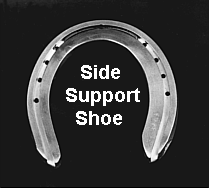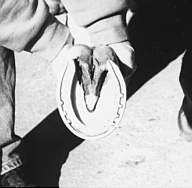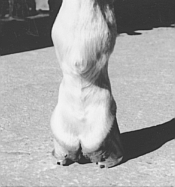

© Walt Koepisch, Jr.
published in the ANVIL Magazine, March 1995
The aluminum side support shoe is designed with one branch wider than the other. At first glance, one would think this is a side weight shoe. However, the light weight of the aluminum will not play a significant role in weighting one side or the other of the hoof. The side support shoe provides extra support to one branch of the hoof, offering a broad base on which that branch can land. In addition to the broad base, the shoe also provides flotation of the wider branch over that of the narrower branch, flotation being the ability to support weight.
While there is a call for side weight shoes, especially with trotters and pacers that are working at speed, the side support shoe addresses other issues.
 |
 Two views of the side support shoe applied to the near hind. |
The flight of a foot depends largely on where or how the foot is resting on the ground at the time of breakover. Taking into account that both phases of the stride - the stance and the flight - are integrally related, it stands to reason that the hoof landing unevenly on the ground will result in less-than-straight flight. This shoe can help the horse travel with increased straightness and improved rhythm by encouraging evenness in the landing pattern of the foot. The change in balance may appear to be minuscule, but will be enough to improve the horse's way of going.
In the case of soft footing, if one branch is bearing more weight than the other, the heavily weighted branch will sink into the ground more than the other branch. However, the combination of the lightweight aluminum and a wider web on one side increases the weight-bearing capability on that side with a broader landing surface. In effect, the foot will stay more level in soft footing and, as a result, travel with increased straightness.
When shoeing a performance horse, it is important to shoe the horse for all possible footing. A horse that is shod with poor conditions in mind will have an edge over the competition. A horse whose way of going puts more weight on one side of the foot will benefit from the side support shoe. An average mover can be moved up a notch or two with the help of the side support shoe. Even the best of movers will have an edge.
One can consider this shoe to be an insurance policy. Picture yourself or someone you shoe for. We are in a pleasure class, and the horse is having a good go. He has settled into a steady, relaxed rhythm. Maybe you have come off the rail to pass someone, and the ground is softer off the rail. If the ground conditions change, the horse will alter its balance and rhythm. That could mean the class. Still worse, the horse could interfere and throw himself off balance even further.

Many horses carry themselves crooked. The off hind foot tends to be low on the outside quarter and may toe out more than the near hind foot. The off hind, while moving forward, will tend to swing in an inward arc, traveling a greater distance than the near hind (see figure). Thus, the rhythm of the horse's gait and his balance are affected. This condition is often associated with paddling or winging. The side support shoe can help the horse overcome these irregularities. Look at it this way: A wagon wheel can roll smoothly only if all the spokes are the same length.
Also of note, the side support shoe can be useful when the horse has a contracted heel. The side support shoe can be applied with the wide branch on the side of the contracted heel.
In most cases, the wide web is placed on the inside branch of the front foot and the outside branch of the hind foot.
Return to the Farriery Articles listing page.